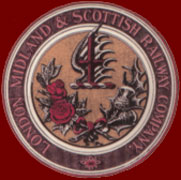London, Midland and Scottish Railway
|
|
The London, Midland and Scottish Railway (LMS1) was a British railway company. It was formed in 1923 by the forced Grouping of over 300 separate railway companies into just four. It was an unwieldy construction, claiming to be the world's largest transport organization, and the largest commercial undertaking in Europe (although they did not say on what basis), including the largest chain of hotels. In 1938, the LMS operated 6,870 route miles of railway (excluding lines in Northern Ireland), but it was not very profitable with a rate of return of only 2.7%. It was nationalised in 1948.
| Contents |
Constituents
The LMS was formed from the following major companies:
- Caledonian Railway 1114.4 miles (1783 km) route mileage
- Furness Railway 158 miles (253 km)
- Glasgow and South Western Railway 498.5 miles (790 km)
- Highland Railway 506 miles (890 km)
- London and North Western Railway (including Lancashire and Yorkshire Railway, amalgamated from 1 January 1922) 2667.5 miles (4268 km)
- Midland Railway 2170.75 miles (3473 km)
- North Staffordshire Railway 220.75 miles (353km)
There were also some twenty-four subsidiary railways, leased or worked by the above companies, and large number of joint railways. In Northern Ireland there were three railways:
- Dundalk, Newry and Greenmore Railway 26.5 miles (42 km)
- Northern Counties Committee's lines 265.25 miles (425 km)
- Joint Midland and Great Northern of Ireland Railway 91 miles (146 km) interests in Ireland
The total route mileage of the LMSR in 1923 was 7790 miles (12464km).
For complete list of all railways see List of constituents of the LMS.
Geography
The LMS principle trunk routes were the West Coast Main Line and the Midland Main Line which linked London, the industrial Midlands and North-West and Scotland.
The railway's main business was the transportation of freight between these major industrial centres. Particularly notable were the Toton-Brent coal trains which took coal from the Nottinghamshire coalfield to London.
History
Early History
The early history of the LMS is dominated by infighting between its two largest constituents, the Midland and the North Western, previously two fierce rivals. Men from each of which believed that their companies way was the right - and only way of doing business. Generally, the Midland prevailed, with the adoption of many Midland practices, such as the livery of crimson lake for passenger locomotives and rolling stock. Perhaps most notably however was the continuation of the Midland Railway's small engine policy.
The Stanier Revolution
The arrival of the new Chief Mechanical Engineer William Stanier, who was head-hunted from the Great Western Railway by Josiah Stamp in 1933 heralded a change in the LMS. Stanier introduced new ideas rather than continuing with the company's internal conflict.
Nationalisation
The LMS was nationalised in 1948 by the Transport Act 1947, becoming part of British Railways. It formed the London Midland Region and part of the Scottish Region. Lines in Northern Ireland were taken into the Ulster Transport Authority (?)
Preservation
Topics
Note: Suggested topics
- People
- Rolling Stock
Further Reading
For a general overview see Whitehouse, P (1997) LMS 150, ISBN 0862880718
External Links
- The LMS society (http://lms-society.org.uk/)
Footnote
1It has been argued that the initials LMSR should be used to be consistent with LNER, GWR and SR. However the London, Midland and Scottish Railway's corporate image used LMS, and this is what is generally used in historical circles. The LMS occasionally also used the initials LM&SR. For consistency, Wikipedia uses the initials LMS. ^^ back to top
| The "big four" pre-nationalisation British railway companies: |
|
Great Western | London Midland & Scottish | London & North Eastern | Southern |


